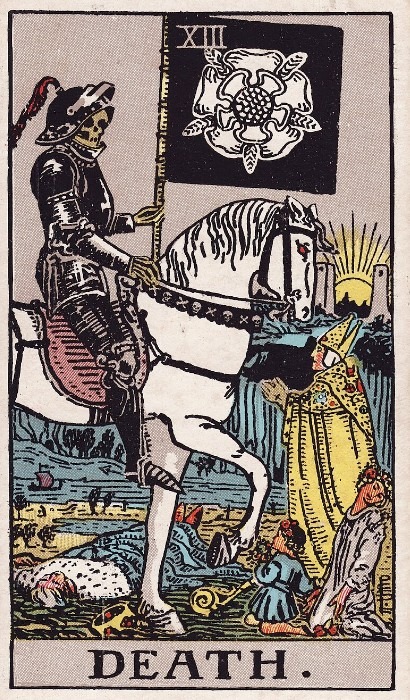
After the hanged man, the fool has found death on card 13, the traditional number of bad luck and misfortune. When it comes to an universal archetype, this is an iconic image of fear.
Initially the fool steps back, unable to stop the rush of adrenaline. We’re conditioned from early childhood to see certain things in definitive ways and death is the hush-hush subject no one wants to talk about. But he’s learning the cards don’t always represent how they appear on the surface.
The death card is an example of this.
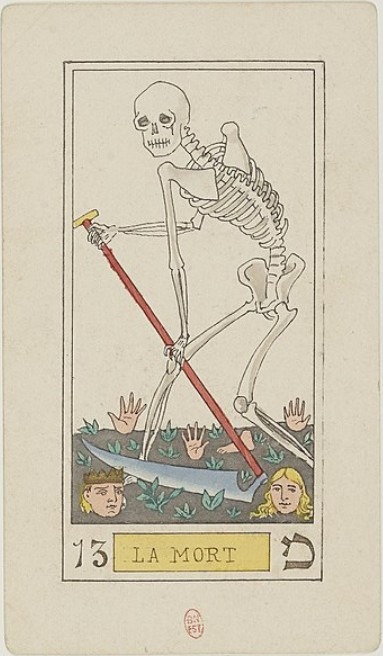
The fool sees a skeleton dressed in black armour, riding a palamino. The horse delicately steps over a king lying prostrate, possibly dead. Kings, like the emperor, operate in the physical world but are separated from their subjects or citizens by their immense wealth and priviledge.
In the world symbolised by the death card, those with dominant egos, accustomed to the trappings of power and gold, cannot survive. Those who rule on earth might live their lives protected from harsh realities but death still comes, eventually.
A bishop has lost his ceremonial staff or crozier. He holds out his hands, pleading or beseeching. Like the hierophant, he is partially protected by doctrines that deal with mysteries so is begging or disputing death’s authority.
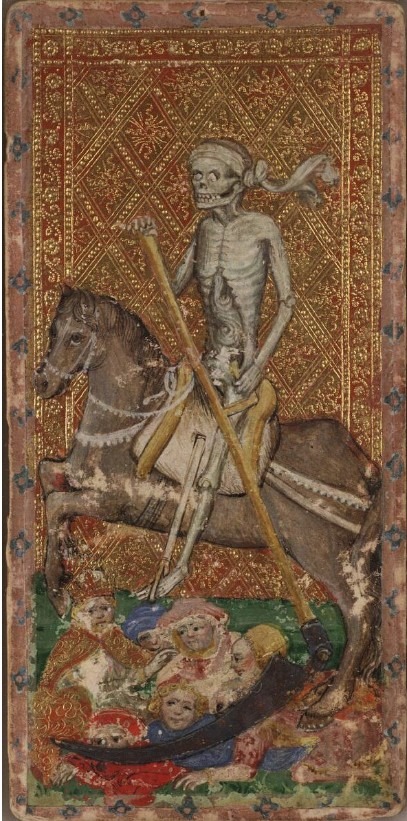
A young boy and a girl are on ther knees. The girl looks away, seeming to ignore what’s happening in front of her. Maybe she simply can’t believe the world she knows is falling apart, unwilling to surrender to the truth that everything comes to an end.
The little boy stares directly at death, whose black flag bears a white rose, the symbol of purity and new beginnings. He is younger than the girl and seems curious, maybe more able to accept change because he doesn’t yet have the knowedge of how it might impact him.
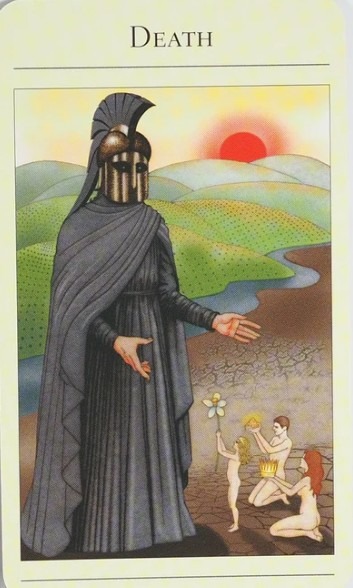
In the background, a boat sails on the river. It might be the underworld Styx or simply the act of flowing. Rivers don’t lose their identity, but their waters are in continual states of transition. Rivers become seas. As Greek philosopher Heraclitus said, you cannot step into the same river twice and this constant state of change lies at the core of life. It’s a lesson the fool has met repeatedly since the magician card at the start of his journey.
The fool sees the sun rising between two white pillars.
Despite the name, the card is also about life and living.
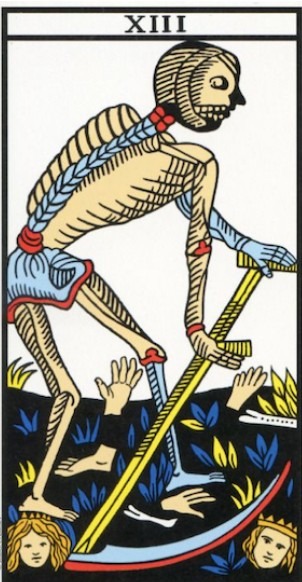
Traditionally, death was often portrayed as the grim reaper, a skeleton or hooded figure wielding a scythe and cutting down people, a medieval image derived from agriculture where scythes were used to harvest crops.
Death has also been personified as an angel, responsible for taking care of the souls of the newly deceased. In Greek mythology, Hermes guided the dead to meet Hades but the angel of death has many names; Azrael, Samael, Sariel and Malak al-Maut.
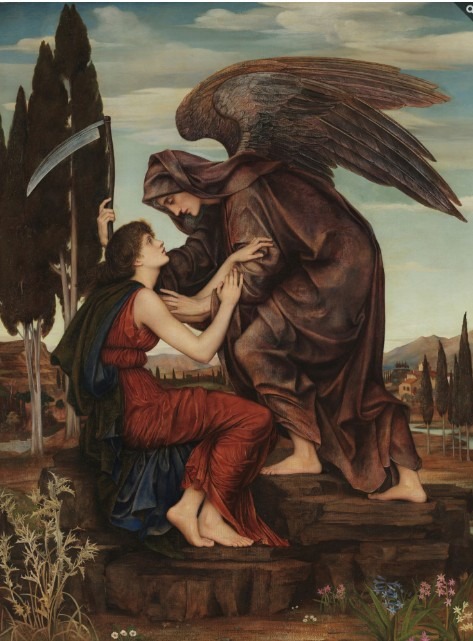
In the tarot, death might look like a stereotype but the card is also a symbol of transition.
The fool needs to swallow his fear, take a deep breath and be ready to watch and listen.
In the older packs, death rode a horse or other creature, reminiscent of 17th century depictions of witches flying to sabbats. The Waite/Coleman Smith card has included a mode of transport but replaced the scythe with a rose.
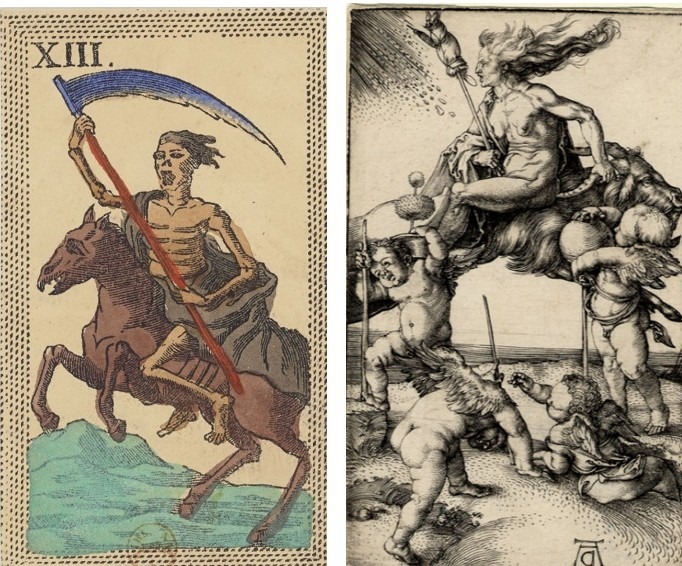
The fool carried a white rose when he set out on his journey, when his life was firmly fixed in the physical world of consciousness. Now he’s face-to-face with the white rose of death.
Here, it signifies change. The rose represents beginnings, which always start clean and pure because they’re new and the fool hasn’t yet begun to incorporate or put his mark on them.
The fool is being asked to step into the unknown, to see himself in a different light. Death represents the next stage of his own transformation.
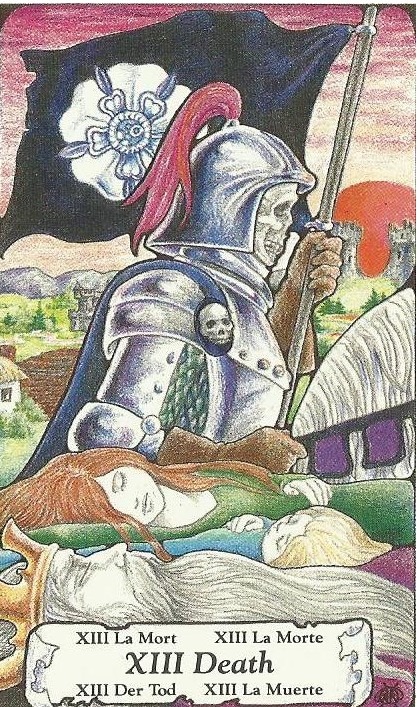
It marks the disintegration of his old self and readjustment to the person he can become. This death is metaphorical and an essential step on the fool’s journey.
This is not going to be easy.
Familiarity can represent security and comfort. Letting go is a difficult process. Death is the space between closing an old door closing and the opening of a new one. It takes the fool back to the first card, the magician, who spoke about action. The first step sets intentions in motion.
If we open the door, the universe will respond with opportunities to increase knowledge and understanding. The fool has touched on this with the hermit who represented solitude for learning and reflection. The hanged man was acceptance of change and taste of surrender. All the cards have been leading to this choice.
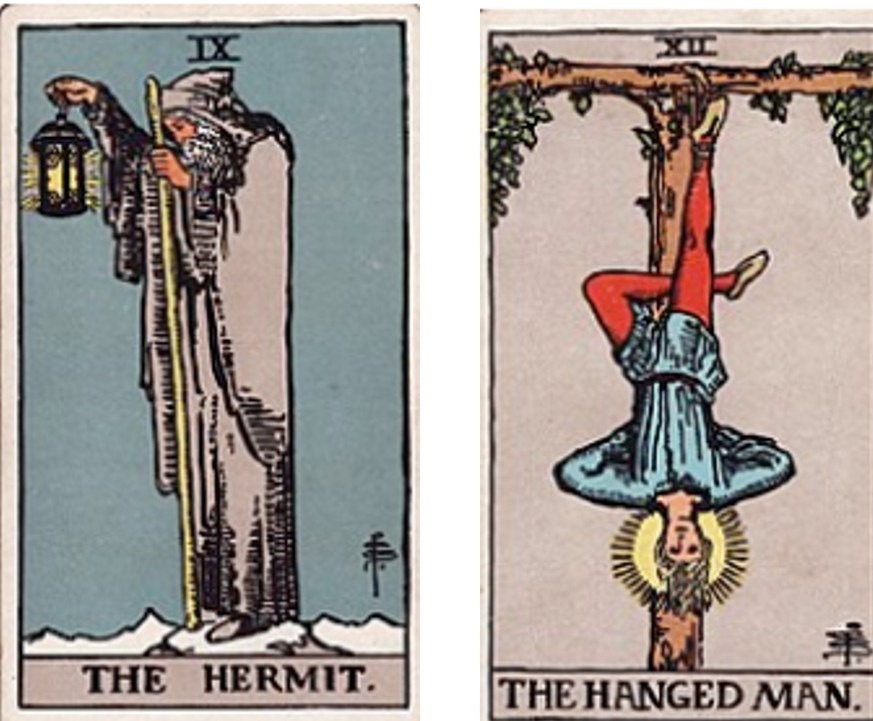
The fool is being asked to abandon the old ways he used to get by. Let go of beliefs which no longer serve him. Put the ego part of his personality to one side.
Ego has been the dominant driver of the fool’s life. It’s the lens through which he’s known the world but death signifies the end of his ego consciousness. It’s time for the outer mask and identities to be laid aside. For the unconscious to rise to the surface.
The fool is afraid. He wants to hold on to the familiar but death is telling him the old must be given up before anything new can fill the space. He’s worried there’s no guarantee. What if this is all a lie or fantasy and there’s nothing else left for him?

At first, the idea of meeting universal achetypes felt strange. The fool hasn’t understood everything he’s been told but has a better awarenss of who he is and accepted much of what he’s learned. After all, there’s been many unarguable truths. They’ve given him answers to questions in ways he never came across at home.
The fool has come a long way but now feels he stands in a void. It’s like the cliff edge again, the point where his journey began. He has to take the next step to in order to progress, but without guarantees he’s uncertain.
Our fool is nearly at the end of line 2. Card 14, temperance, will be a relief but he doesn’t yet know that.
Join us for the next step on this walk through the tarot, where the fool will come face-to-face with the angel of temperance and see with his own eyes what can happen if the invitation from death is followed.
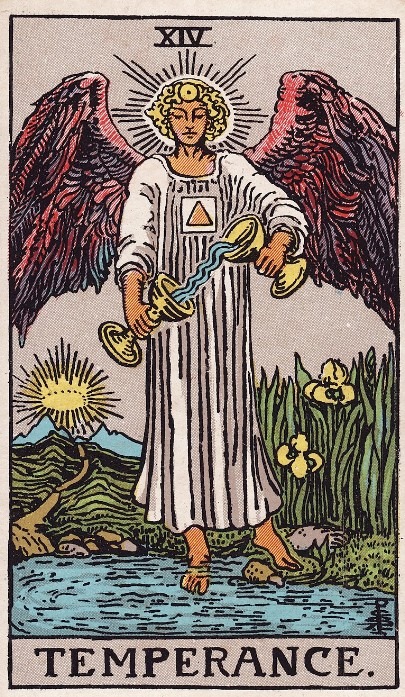
images my own, or copyright free from wikipedia commons and https://pixabay.com/